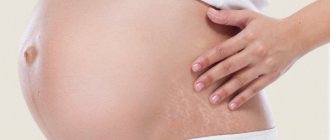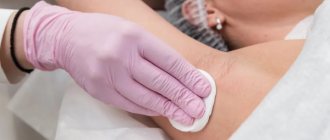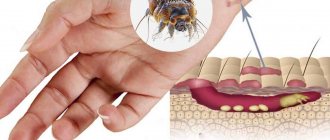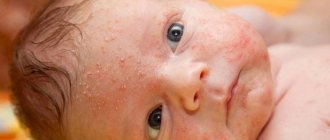What are the causes of rashes in pregnant women?
A rash during pregnancy very often appears on a woman’s skin. There is no need to panic when you see her. It is imperative to look for the reason that caused this. In most cases, skin rashes during pregnancy are a consequence of hormonal changes. But it is important to remember that, in addition to physiological reasons, there may be others that warn of the development of very serious pathologies. In such a situation, a rash can threaten the health and life of the pregnant woman and her baby. Rashes during different periods of pregnancy indicate the presence of a separate type of problem.
- The first reason may be dermatosis, which, as a rule, is visible in the last months of pregnancy, due to hormonal changes in the body of the young mother. The main symptom of dermatosis is a rash similar to nodules and plaques, which are visible on the stomach, thighs - where there are stretch marks. After some time, the rash can merge and form large plaques that cover the buttocks, legs and even the back. A rash on the chest is also possible during pregnancy, but it disappears when the baby is born. Hormonal rash during pregnancy is not capable of harming mother and baby, and therefore is not dangerous.
- The second cause may be rubella. This is not just a rash, but a disease. Such a rash during pregnancy poses a danger to the child and mother. Rubella, which occurs in the first months, can cause cataracts, deafness, heart disease, and damage to the nervous system in the baby. Doctors recommend terminating a pregnancy if a woman has rubella in the first months of pregnancy. Symptoms of this disease: very small pale pink pimples appear all over the body, headache, nausea, and fever.
- A third cause of the rash may be measles. This rash appears during pregnancy in expectant mothers who do not have immunity to this disease. When a mother gets sick with measles in the first months of pregnancy, the baby is born weak-minded and has other pathologies. What are the symptoms of this disease? A rash similar to tubercles appears on a woman’s body. First of all, they are visible on the neck and face, and then on the torso and arms. The legs are the last to be affected. As with rubella, women who have had measles are advised to terminate their pregnancy.
- The fourth reason for the appearance of a rash can be herpes, which is an infectious disease. Most congenital diseases of the fetus occur after suffering this infection. If the expectant mother is infected with herpes for the first time, there is a 50% chance that the child may also be infected. When the disease already exists and it only worsens, infection of the baby is possible only in rare cases. It is possible to become infected with herpes through sexual intercourse, kissing, and through objects of daily use. Symptoms include: small red rashes with blisters containing clear liquid. They become red, itch very much and a strong burning sensation is felt. Time passes and ulcers form in place of the blisters. In the first trimester it is very dangerous to suffer from infection. As a result, there is a high probability that the baby will develop mental retardation, as well as problems with the cardiovascular system. If the mother got sick while pregnant in the last months and infected the baby, then in the future he may face problems such as encephalitis, hepatitis, pneumonia.
- The fifth cause is chicken pox. This disease is most dangerous in the first and last months of pregnancy. It often entails miscarriage and severe defects in the development of the baby. If the mother gets sick with smallpox in the last months, she can infect the baby, which will lead to pneumonia and hypoxia. The pathology has the following symptoms: pink spots appear on the body, with bubbles containing a clear liquid inside. After a while they become crusty and very itchy.
- Scabies takes sixth place in the ranking. With this disease, blisters and bumps form on the skin. Most often they are between the fingers and toes. The rash is very itchy, but does not pose a danger to either the mother or the unborn child.
- The seventh and final cause of rash is allergies. It is most common among pregnant women. In this position, the mother’s body can react in a special way to various substances, including allergens. With allergies, the rash takes the form of blisters and large red spots.
READ ALSO: Rash after flu shot
We also recommend reading: Implantation retraction
Fighting rashes
Naturally, it is easier to prevent a rash and overcome it in the earliest stages than to prolong the soreness and spend a lot of time and money on treatment. Therefore, below we will describe some tips that will be useful to every expectant mother.
- First: you should monitor your hygiene as often and carefully as possible, and use baby products instead of regular products.
- Second: carefully monitor your diet and limit the consumption of foods that contain chemicals and allergens. This also includes cosmetics.
- Third: moisturizing some areas of the skin can prevent rashes, and it is advisable to use baby creams for this.
It is also worth considering that the rash can be caused by nervous tension, which means that you should be in calm conditions.
We also recommend reading: Swelling of the legs after childbirth
When a rash has been discovered, it is worth starting an active fight against it: apply cold compresses, but do not get carried away with herbal decoctions, because they can cause allergies.
An excellent solution is baking soda in a proportion of about a tablespoon with water. You should not get rid of the rash on your own, because there can be many reasons for the occurrence of this disease, and only a doctor can assess the severity of the rash, its cause and recommend the necessary drugs to combat it.
Rubella
The appearance of a pale pink rash on the body during pregnancy should be an alarm for the expectant mother and doctors, especially if it is accompanied by fever, nausea, weakness and headaches, and enlarged occipital and cervical lymph nodes. These symptoms are characteristic of rubella, an acute infectious disease caused by a virus. Typically, infection occurs in childhood, after which the person acquires immunity; Vaccination is also practiced. However, in some cases, infection may occur in adults.
Rubella infection is extremely dangerous for pregnant women, especially when it occurs in the first trimester. The disease can cause serious disturbances in the development of the fetus, which can lead to cataracts, deafness, heart defects, severe damage to the skeletal system and the central nervous system. If rubella is detected in the first trimester, pregnancy is often terminated. If the fact of infection is detected at a later date, additional examinations are required to determine the risk of developing malformations.
Bottom line
No pregnant woman can protect herself from a rash, because even heat can cause it. If you are sure that it was sweating that caused the rash, then special compresses, keeping the body clean, and moisturizing creams will help. But if formations on the skin appear after eating certain foods, then you cannot do without consulting a doctor, because an allergic reaction is a signal that the liver is not coping with its job. In this case, the doctor will prescribe special medications that will cleanse the body of toxins.
Self-medication is considered dangerous not only for the pregnant woman, but also for the fetus, so following the advice of girlfriends and forums can lead to problems not only with the female body, but also with the baby’s body. This means that in cases where something new appears on the body that is unusual for your body, you should immediately go to the doctor.
On what parts of the body does rash most often occur during pregnancy?
We recommend reading: Sleeping during pregnancy, Bleeding gums during pregnancy, Bleeding from the nose during pregnancy
In order to better understand what pathology this or that rash is a symptom of, let’s talk about the characteristic places of its formation.
- Rash on the abdomen during pregnancy. If the expectant mother sees small rashes with blisters on this part of her body, do not panic - this is just a hormonal disorder that often occurs in pregnant women. This rash appears not only on the stomach, but also on the arms, back, buttocks, thighs, and chest. Another common cause of a rash can be an allergic reaction. It occurs due to poor nutrition, contact with household chemicals, animal hair, and the use of low-quality cosmetics. If it is a hot season, then prickly heat may appear on the body - small spots that do not itch. She criticizes those mothers who wear clothes made from non-natural fabrics more. A rash on the abdomen during pregnancy indicates that the mother has infectious diseases or disturbances in the normal functioning of internal organs. A woman rarely feels itching in this state.
- Rash on hands during pregnancy. In such places, the reaction appears when women who are carrying a baby have a weakened immune system and have a hormonal disorder. In many cases, allergies are the cause of rashes. When an allergic reaction to something occurs, it can later turn into a bacterial infection. When this happens, you need to be careful that it does not become chronic, as it provokes eczema. There are cases when the level of the hormone estrogen in the blood of the expectant mother increases, then the palms become covered with a rash. This occurs due to the fact that small vessels dilate. The rash looks like stars, dots, and dashes. Sometimes it indicates liver problems.
- Rash on legs. If a rash appears in this area, you need to think about problems such as dermatosis, allergies, and infections. As mentioned above, the most dangerous rashes are measles and chickenpox.
- Rash on the face during pregnancy. When carrying a baby, most mothers develop acne. The areas they cover are the cheeks, chin, forehead. Lumps and pimples appear on them. This is not dangerous for mother and child, as it is a consequence of hormonal imbalance in the woman’s body.
- Any rash around the eyes is evidence of demodicosis. The causative agent of the disease is the demodex mite. It lives in the eye hair follicle and sebaceous glands.
- A rash in the mouth during pregnancy is the cause of various infectious diseases - chickenpox, measles, herpes, rubella. So, stomatitis can also manifest itself.
READ ALSO: Mask for blackheads with activated carbon and gelatin, recipe
We also recommend reading: Hepatitis C during pregnancy
Hyperpigmentation
This is the appearance of dark spots on the face or other parts of the body. The phenomenon is caused by an increase in melanin production and goes away after childbirth, but can persist for several years.
An example of hyperpigmentation during pregnancy is melasma, known as “mask of pregnancy,” which is characterized by brown patches on the face, cheeks, nose, and forehead. To solve this problem, you need to consult a dermatologist.
To reduce stains, it is recommended to follow simple rules:
- limit your stay on the street during the period of solar activity from 10:00 to 14:00;
- in hot weather, use sunscreen with a factor of 30 or higher;
- wear a wide-brimmed hat.
Allergy
Pregnant women often experience allergic skin reactions, even if the woman has not previously suffered from allergies. The reason for this is changes in the functioning of the endocrine and immune systems. A variety of factors can cause an allergic rash during pregnancy - food, medications, pet dander and much more.
Most often, such rashes look like small blisters or spots, papules. The rash is accompanied by severe itching and redness of the skin and can affect both individual areas of the body and its entire surface. An allergic rash is persistent and difficult to treat with conventional cosmetics or medications; The main condition for getting rid of it is to eliminate contact with the allergen.
Description of the disease
The cause of an allergy is always the same - a certain irritating substance enters the body, which the defense system determines as harmful. Histamine, a special hormone that is designed to defeat the “enemy,” begins to enter the blood en masse.
As a result, allergy symptoms arise, which in some cases cause a lot of discomfort to a person, and sometimes even become a threat to life (Quincke's edema, anaphylactic shock).
During pregnancy, the hormonal system undergoes a restructuring, and the immune system is not left out - those substances that previously did not pose any danger now become allergens. The most common irritants include:
- plant pollen;
- chemicals;
- tree bark;
- animal hair;
- synthetic fabric;
- some foods, especially sweets;
- medicines;
- cosmetics.
Anything can become an allergen. Moreover, if before a woman did not experience any problems at all and did not know what a rash was, then with the onset of pregnancy the problem becomes very urgent, and it cannot be ignored.
What kind of rash does a woman who is carrying a child get?
The rash on the body can vary. Each will indicate a specific disease, infection or pathology.
- Red rash. Appears, in most cases, due to dermatosis. It is not dangerous to the life of a woman or a child. It is very itchy if it appears in the last months of pregnancy. Those who suffer most from dermatosis are those pregnant women who are expecting twins or who gain weight very quickly while carrying a child. In appearance, the rash looks like small bumps.
- Minor rash. Occurs with urticaria. It is very itchy and uncomfortable. Most often, these are food allergies, hormonal disorders, and poor personal hygiene on hot days.
- Acne. The cause of such a rash during pregnancy is an increased level of progesterone and, accordingly, increased secretion of sebum or toxicosis, which leads to dehydration.
- Allergic rash. It is characterized by the appearance of very severe itching and occurs due to poor nutrition and medication.
- Hemorrhagic. It appears in the groin, on the buttocks, on the inside of the elbows, under the knees and armpits. This happens due to damage to the vascular walls by infectious agents - blood cells leave the vessels.
- Purulent rashes. Various microtraumas on the skin and infections may subsequently occur. This rash is very itchy. Reasons: weakened immunity, chronic diseases, increased sweating, contaminated skin.
Symptoms
The difficulty is that urticaria is very similar in its symptoms to some skin diseases.
Sometimes only a doctor can correctly assess the symptoms and draw conclusions about their origin, which allows you to prescribe the correct treatment.
The localization of the rash is very extensive; signs of allergies during pregnancy can appear in any part of the body: on the chest, face, arms, stomach, back, buttocks, etc. – you can clearly see in the photo.
The general signs are the same, regardless of location:
- pink or bright red rashes on the skin;
- the area of the rash ranges from a millimeter to 15-17 centimeters;
- swelling of the skin is observed in the area of the rash;
- burning and itching, in rare cases painful sensations;
- general weakness;
- loss of appetite;
- insomnia.
Such symptoms will force you to climb the wall, so the woman becomes nervous and sometimes aggressive. Insomnia causes headaches. Since any allergy is in some way comparable to intoxication, an increase in temperature is possible, which in pregnancy poses an additional threat to the baby.
Dermatosis
A red rash during pregnancy is often the result of dermatosis, a disease whose causes have not yet been fully established. Such rashes appear in the area of stretch marks that appear on the abdomen; Most often, dermatosis occurs in the third trimester; in the early stages of pregnancy, a rash of this type is rare. Most often, primiparous women suffer from this disease.
Dermatosis looks like small nodules and red plaques; their diameter rarely exceeds 1-2 millimeters. With a long course of the disease, the nodules merge together, forming large areas of skin damage. A few days after it appears, the rash may spread, affecting the skin of the chest, legs, buttocks and back.
Usually, within 1-2 weeks after birth, the rash disappears without a trace, without having a serious impact on the health of the mother or fetus. If redness and itching cause severe discomfort, you can consult a doctor - for dermatosis, local hormonal and non-hormonal agents are most often used.
READ ALSO: Gel, cream-gel, spray, shampoo, cream Cynovit: instructions for use, price, reviews for acne
Treatment
At this stage lies the main difficulty - most of the medications that are traditionally used to combat allergies are not suitable for pregnant women, especially when it comes to the early stages. Such prohibited drugs include antihistamines, which in other cases become the basis of therapy.
However, doctors allow a number of medications for use, but not in the first trimester:
- Suprastin;
- Diazolin (under strict medical supervision);
- Zyrtec;
- Claritin;
- Loratadine.
The last three drugs have not undergone clinical trials, but, according to statistics, the harm from them is small. They are usually prescribed only in the most extreme cases. Be that as it may, a pregnant woman should take any drug with great caution, noting the dynamics of her health in a special journal.
In the case of anaphylactic shock (one-time exposure to a large amount of allergen on the body), there is a significant risk to life. The procedure is as follows:
- call an ambulance;
- place the woman on her back;
- give any antihistamine;
- monitor blood pressure (during anaphylactic shock it drops sharply).
Once the emergency team arrives, the girl will be safe. It’s better not to refuse hospitalization!
Important! Pregnant women should never take Tavegil, Diphenhydramine, Telfast, Pipolfen, Azelastine. They are fatal to the fetus. You should also completely abandon any traditional methods of treatment.
How to treat a rash during pregnancy?
Since any rash occurs as a result of various diseases, to eliminate it, you need to treat the reason why it occurred. In order to prevent the appearance of an unpleasant rash, it is important to adhere to personal hygiene, eat right, and exclude from the diet those foods that can cause allergic reactions. If you have allergies you need to use antihistamines. They are available in the form of tablets, ointments, drops.
We also recommend reading: Dental treatment during pregnancy
When the rash is infectious, you should not self-medicate, but strictly adhere to the recommendations of a specialist doctor.
Remember: if you notice the problem in time and go to the hospital for help, both you and your baby will not suffer. You can treat rashes at home only with the permission of a doctor and in no other way. Be vigilant about your health and then everything will be fine.
Skin diseases during pregnancy
The content of the article
Types and reasons for changes:
- Dark spots
. Due to an increase in the level of pigment - melanin, dark spots appear on the skin. - Melasma
. A form of hyperpigmentation, also known as "mask of pregnancy". - Stretch marks
. They can appear by the third trimester and sometimes remain for life. - Pimples.
Even those with clear skin can develop acne during pregnancy, but some forms of treatment for this problem should be avoided by using medications prescribed exclusively by a gynecologist. - Phlebeurysm
. Pathology can develop, but varicose veins often go away after childbirth.










